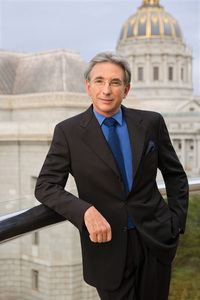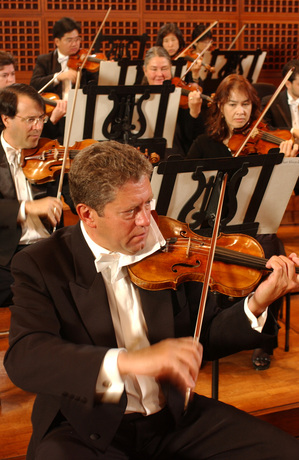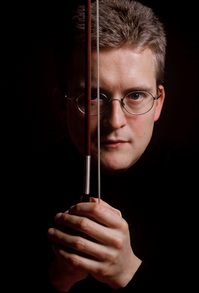San Francisco Symphony returning with violinist Christian Tetzlaff
It’s always a gala occasion when the San Francisco Symphony Orchestra arrives in town for a concert with its dynamic director, Michael Tilson Thomas.

Michael Tilson Thomas, San Francisco Symphony music director.
This year, the University Musical Society doubles the pleasure, with two concerts by the San Francisco, back to back, Friday and Saturday evening, March 19 and 20, at Hill Auditorium. And to gild the lily, on March 20, on the occasion of its 15th Ford Honors Program, UMS awards the orchestra and Tilson Thomas its Distinguished Artist Award.
The award is presented to begin Saturday’s concert, and the events also include pre-concert dinner and post-concert champagne afterglow at the Michigan League. Proceeds benefit the Ford Honors Program, underwritten by the Detroit auto maker. The program raises funds for UMS education programs.
PREVIEW |
Dinners and champagne are great, but for most UMS patrons, the weekend’s pieces de resistence will be the concerts themselves, and rightly so. (There are also several interesting residency activities open to the public.)
Friday brings the extraordinary violinist Christian Tetzlaff back to Ann Arbor, to play the Tchaikovsky Violin Concerto in D Major, Op. 35, with the orchestra. Also on the bill: Kissine’s newly minted “Post-scriptum,” Ravel’s evocative “Valses nobles et sentimentales” and Liszt’s Symphonic Poem No. 2: “Tasso — Lament and Triumph.”
Saturday brings the UMS Choral Union to the stage, along with soprano Laura Claycomb and mezzo-soprano Katarina Karneus, to join the orchestra and Tilson Thomas - recently awarded the National Medal of Arts — for Mahler’s transcendent Symphony No. 2 in c minor, “Resurrection.”
Mahler, of course, is a specialty of the San Francisco and MTT, as Tilson Thomas is frequently referred to. Its Mahler Project — recording all the orchestral works and the works for voice and orchestra — began in 2001 and is essentially complete. Many of the recordings have garnered Grammys and other awards.
In pairing with the Choral Union, directed by Jerry Blackstone, the San Francisco is joining with another Grammy-winning group. And one that has sung Mahler — and this symphony in particular — before.

San Francisco Symphony performs works by Tchaikovsky and Mahler on Friday and Saturday.
“We’ve done it several times,” said Blackstone, including with the Ann Arbor Symphony and the Detroit Symphony. “So it’s an old friend for many in the group.”
The Choral Union began to prepare the Mahler once again at the end of January; in addition to working with Blackstone, the members got a chance to rehearse with San Francisco Symphony Chorus Director Ragnar Bohlin when he was here a few weeks back as guest conductor of the amazing Swedish Radio Choir.
Over and above the technical challenges it presents for the chorus, for Blackstone, as for many listeners, the “Resurrection” symphony is always an emotional experience.
“The last time we did it with the DSO, I just sat through every rehearsal and performance in tears,” he said. “Over and over again, it is just overwhelming. It’s just incredibly beautiful and moving. And the last movement is certainly one of the great musical movements in all of the repertoire.”
While the Tchaikovsky concerto that is the centerpiece of Friday’s San Francisco concert is an audience favorite, it began its life under the cloud of “unplayability” and a rejection by the initial dedicatee, the famed violinist Leopold Auer.
Violinist Tetzlaff, reached at a rehearsal in Germany where Schubert and Shostakovich piano trios were on the music desks, like most violinists since, embraces the work.
“First of all,” he said, “it’s a piece that’s just fantastic to play. The physical joy is fantastic in this piece, so it’s a work I always love to come back to.”

Acclaimed violinist Christian Tetzlaff joins the San Francisco Symphony on Friday.
And come back to it he has, for more than 20 years.
Asked how his ideas on the work have changed with time, he emphasized adherence to Tchaikovsky’s musical instructions.
“I wouldn’t say I’ve developed any new concept in playing it,” he said, “but with the years, you have more freedom in what you want to say, freedom in the way you make a little turn, for example. And there are some tempi and dynamics that just belong to the piece, some important things.”
These are things not every violinist adheres to, but which Tetzlaff feels strongly about. Tchaikovsky, for example, asks that the violinist play the entire central “Canzonetta” movement with a mute.
“If he writes that, why wouldn’t you?” Tetzlaff asks rhetorically.
“His idea is a picture in sepia, a sad story, a canzonetta, a little song.” Tetzlaff takes seriously the movement’s “Canzonetta” title — and its tempo marking, which is faster than that of the first movement.
“It’s not a big love song. But it’s been handed down from teacher to teacher to do it differently. But I’m with Piotr on this,” he added, referring to Tchaikovsky by his first name, “and my freedom is small.”
There may be small outbursts, he said, but this slow movement is not the place to demonstrate “how big a violinist you are.”
He also decries some of the cuts in some performances of the concerto.
“Many people today play with weird cuts,” he said. “Everything Tchaikovsky wrote makes sense, and when people make cuts, they are taking out the grit, the places where he is being stubborn and repetitive, running against a wall again and again.”
Some players add arpeggios, too, decorating notes that Tchaikovsky just sat on, Tetzlaff noted.
But by sticking to the score — a point he emphasized — the player retains the work’s essential Russian character and its wildness. And there is so much in the score to give the player pleasure.
“It’s probably not even the treatment of the violin, but the way the melodies are conceived with the violin in mind,” he said. “They are so exuberant, joyful in a way.”
The dance inspiration is strong here, he said. Look to Tetzlaff and the San Francisco for an inspiring pas de deux.
Susan Isaacs Nisbett is a free-lance writer who covers classical music and dance for AnnArbor.com.
San Francisco Symphony Orchestra members talk about recording Mahler's Symphony No. 8:


Comments
Liz
Mon, Mar 15, 2010 : 9:29 a.m.
Please note: the Sunday master class has extremely limited seating and the public will be seated on a first-come, first-serve basis. To guarantee yourself a seat, please enter the contest at http://umslobby.org/?p=1731.
texorama
Sat, Mar 13, 2010 : 8:56 a.m.
Props for calling up Christian Tetzlaff in Germany for the story!